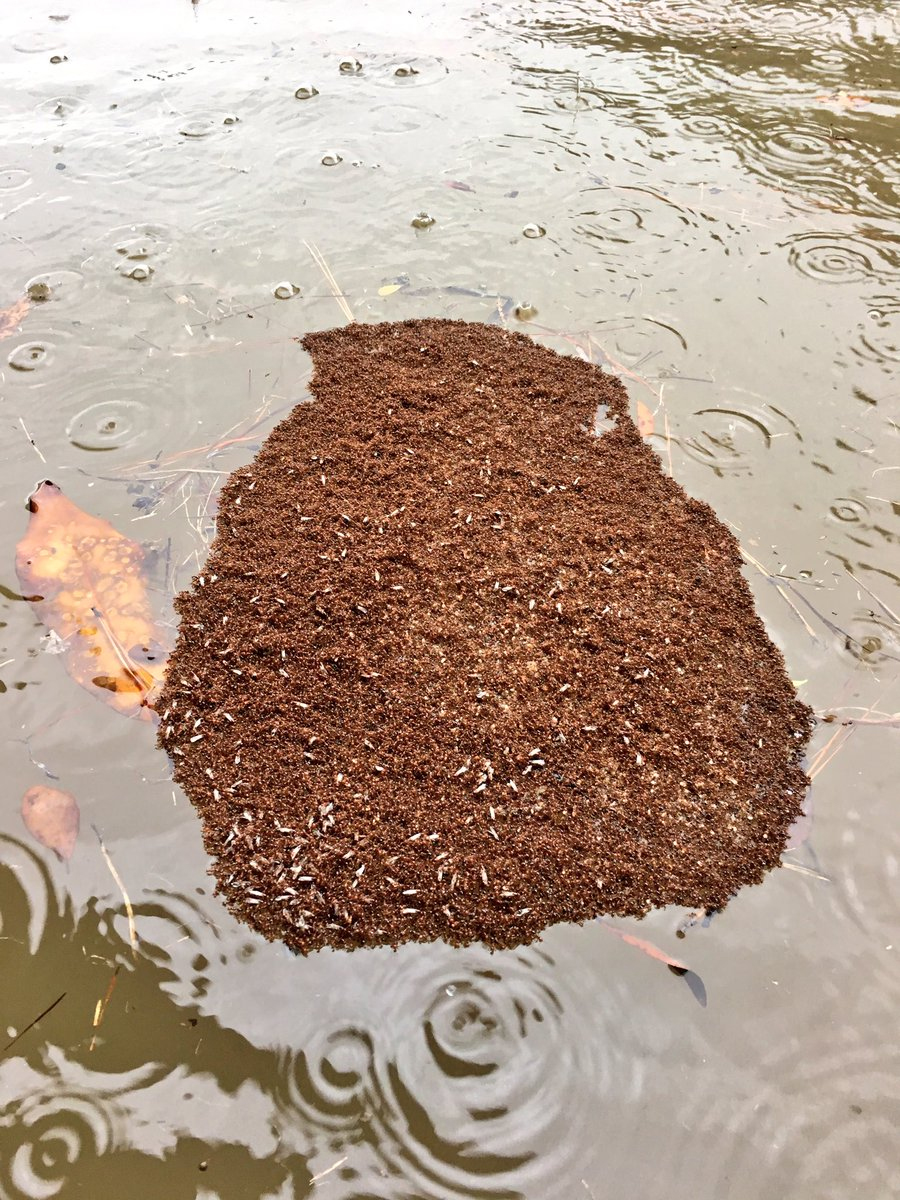
A floating fire ant mat in Houston this week is one of the lesser known hazards of water rescue. Photo by Omar Villafranca NBC DFW Channel 5.
What’s reddish-brown, rides the water like an air mattress, changes shape like an amoeba, and stings like the devil? If you answered fire ants floating in floodwater, you’ve probably been in Texas high water before.
Floods bring all sorts of wildlife into close and sometimes uncomfortable contact with people, but none perhaps so uncomfortable as fire ants. When their mounds are flooded, fires ants survive by riding air bubbles to the surface, joining feet (tarsi) with nest mates, and floating. The ingenious behavior that allows ants to float is the result of special waterproof waxes on the fire ant’s body, as well as via the colony’s ability to close ranks and form a waterproof pocket around the precious queen.
Floating colonies can look like ribbons, streamers or a just a massive blob of ants floating on the water. These fire ant rafts can contain all of the colonies’ members—worker ants, brood (eggs, larvae, pupae), winged reproductive males and females, and queen ants. Besides being a way to survive a flood, rafts are another way fire ants colonize new areas.
Research done a few years ago shows that this behavior does not necessarily involve self sacrifice on the part of the ants. Ants on the top of the raft slowly change positions with the ants on the bottom, supplying the whole colony with oxygen and allowing longer survival. In the laboratory floating fire ant rafts survived from 24 hours to 12 days.
But for Texans sloshing through flood waters, the most important fact about floating fire ants are the stings. Before flooding, fire ant colonies may contain up to 100,000 worker ants. To my knowledge, no survey has been made of raft sizes in the wild, but they certainly can range from thousands to tens of thousands of ants. That’s a lot of potential stings.
According to A&M AgriLife entomologist Dr. Paul Nester, author of “Flooding and Fire Ants:
Protecting Yourself and Your Family,” the other thing to know is that you don’t want to bump into one of these colonies while wading or swimming. Once contact is made, he notes, they disperse explosively, quickly covering clothes or skin. After that the only thing to do is brush them off as quickly as possible. Sprinkling water or submerging is no solution as the fire ants will only hold on more tightly.
Soapy water may be the fire ant’s Achilles’ tendon, however. Research has shown that soapy water spritzed on a floating fire ant raft will sink and kill it. The soap acts to break the hydrophobic coating on the fire ants bodies, causing them to drown. Plus, soap is mildly insecticidal against many insects.
So if you live in fire ant country, and you have to be out in floodwaters over the next few days, here’s what I recommend:
- Give any floating ant rafts you see a very wide berth. At the edges of these rafts worker ants splay their legs ready to grab any dry object. If that happens to be a boat, oar or you, they will quickly swarm from the water and sting readily.
- Be equally careful with handling and moving flood debris, as ants may be hiding within. Use gloves and a shovel or other implement when first moving any flood debris, especially if it has been sitting for a few days.
- If you are on the water and seeing floating fire ant mats, it would be a good idea to carry liquid dish washing detergent (e.g., Dawn or Ivory) and a sprayer or squirt bottle. 1-2 Tablespoons per gallon of water is sufficient to sink and kill a floating mat. Soap will also be handy for washing off any ants that get in the boat or on someone.
- If soapy water is not available, immediately break off contact with the raft and peel off ant-covered clothing. Brush ants off your skin with your hands. Don’t try to wash off with plain water.
- If you know you are allergic to bee or fire ant stings, either carry an epi-kit, or else find a different way to serve flood victims. You don’t want to end up in the water as a victim yourself.